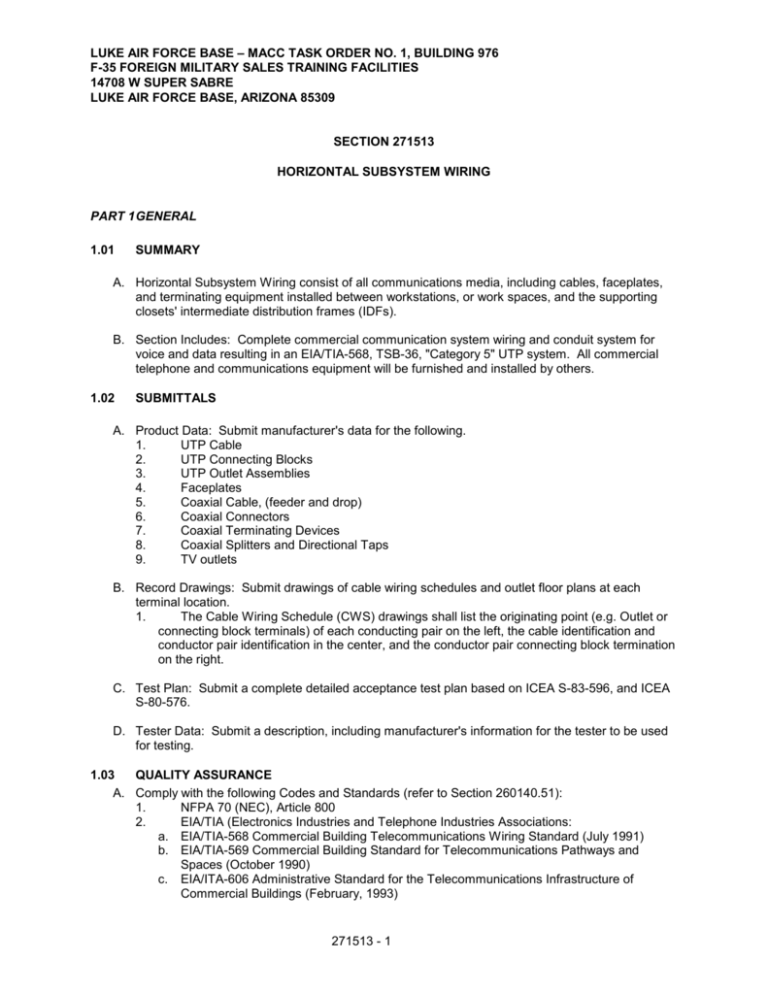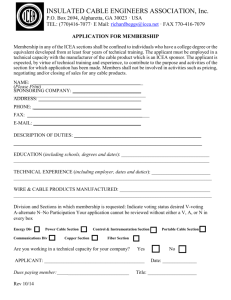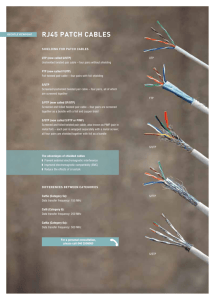271513 Horizontal Subsystem Wiring
advertisement

LUKE AIR FORCE BASE – MACC TASK ORDER NO. 1, BUILDING 976
F-35 FOREIGN MILITARY SALES TRAINING FACILITIES
14708 W SUPER SABRE
LUKE AIR FORCE BASE, ARIZONA 85309
SECTION 271513
HORIZONTAL SUBSYSTEM WIRING
PART 1 GENERAL
1.01
SUMMARY
A. Horizontal Subsystem Wiring consist of all communications media, including cables, faceplates,
and terminating equipment installed between workstations, or work spaces, and the supporting
closets' intermediate distribution frames (IDFs).
B. Section Includes: Complete commercial communication system wiring and conduit system for
voice and data resulting in an EIA/TIA-568, TSB-36, "Category 5" UTP system. All commercial
telephone and communications equipment will be furnished and installed by others.
1.02
SUBMITTALS
A. Product Data: Submit manufacturer's data for the following.
1.
UTP Cable
2.
UTP Connecting Blocks
3.
UTP Outlet Assemblies
4.
Faceplates
5.
Coaxial Cable, (feeder and drop)
6.
Coaxial Connectors
7.
Coaxial Terminating Devices
8.
Coaxial Splitters and Directional Taps
9.
TV outlets
B. Record Drawings: Submit drawings of cable wiring schedules and outlet floor plans at each
terminal location.
1.
The Cable Wiring Schedule (CWS) drawings shall list the originating point (e.g. Outlet or
connecting block terminals) of each conducting pair on the left, the cable identification and
conductor pair identification in the center, and the conductor pair connecting block termination
on the right.
C. Test Plan: Submit a complete detailed acceptance test plan based on ICEA S-83-596, and ICEA
S-80-576.
D. Tester Data: Submit a description, including manufacturer's information for the tester to be used
for testing.
1.03
QUALITY ASSURANCE
A. Comply with the following Codes and Standards (refer to Section 260140.51):
1.
NFPA 70 (NEC), Article 800
2.
EIA/TIA (Electronics Industries and Telephone Industries Associations:
a. EIA/TIA-568 Commercial Building Telecommunications Wiring Standard (July 1991)
b. EIA/TIA-569 Commercial Building Standard for Telecommunications Pathways and
Spaces (October 1990)
c. EIA/ITA-606 Administrative Standard for the Telecommunications Infrastructure of
Commercial Buildings (February, 1993)
271513 - 1
LUKE AIR FORCE BASE – MACC TASK ORDER NO. 1, BUILDING 976
F-35 FOREIGN MILITARY SALES TRAINING FACILITIES
14708 W SUPER SABRE
LUKE AIR FORCE BASE, ARIZONA 85309
d. EIA/TIA TSB-36 Additional Cable Specifications for Unshielded Twisted Pair (UTP)
Cables (1991)
e. EIA/TIA TSB-40A Additional Transmission Specifications for Unshielded Twisted Pair
(UTP) Connecting Hardware (1992)
3.
ICEA INSULATED CABLE ENGINEERS ASSOCIATION
a. ICEA S-56-434 Polyolefin Insulated Communications Cables (1983; 5th Edition; R 1991)
b. ICEA S-80-576 ICEA Standard for Communications Wire and Cable for Wiring of
Premises (Sept 1988, 2nd Edition)
PART 2 PRODUCTS
2.01
MATERIALS
A. Outlet boxes, conduits, pull tapes, cover plates, and power supplies grounding shall be in
accordance with Specifications and the applicable and referenced Sections of Division 26.
B. Conduit:
1.
Service conduit shall be rigid steel or PVC, concrete encased, and steel reinforced
through the foundation wall and for at least ten feet outside the wall. Size of conduit shall be
4-inch minimum unless otherwise noted on the drawings. Refer to buried conduits for further
requirements in Section 16110.
2.
Distribution conduit shall be thin-wall. Conduit sizes are based on the use of one (8 pair)
cable in 3/4 inch conduit, two (8 pair) cables in one inch conduit, and three (8 pair) cables in
11/4 inch conduit.
2.02
STANDARD PRODUCTS
A. All Products as provided shall be the standard Commercial-Off-The-Shelf (COTS) products of a
manufacturer(s) regularly engaged in the manufacture of such products.
B. All products shall be of typical commercial design that comply with the requirements specified and
be readily available through manufacturers and manufacturer's distributors.
C. All products shall be new and free of defects.
2.03
UNSHIELDED TWISTED PAIR WIRING (UTP)
A. All wiring shall conform to the requirements of EIA/TIA TSB-36, "Category 5" UTP wiring.
B. All wire shall be #22 or #24 AWG.
C. All runs shall be dual 4 pair, unshielded, and individually jacketed for each combination. All runs
shall be terminated in dual eight position jacks (RJ45 Type) at the station end and on Category 5,
66M150 connecting blocks. Each jack shall have an individual wire.
D. Voice and data terminations shall be separate and distinctly identifiable, as well as clearly
designated with corresponding jack numbers.
E. Twisted pair integrity shall be maintained up to one-half inch from termination points.
F. All runs shall be direct and less than 270 feet (90 meters), having no splice points or bridge
connections.
271513 - 2
LUKE AIR FORCE BASE – MACC TASK ORDER NO. 1, BUILDING 976
F-35 FOREIGN MILITARY SALES TRAINING FACILITIES
14708 W SUPER SABRE
LUKE AIR FORCE BASE, ARIZONA 85309
G. All penetrations shall be fire-stopped with appropriate material.
H. Cable shall be supported and shall be allowed to lay on ceiling tiles or be fastened to existing
electrical conduits, steam pipes, sprinkler pipes, insulated pipes or be routed in such a fashion as
to not obstruct access hatches, doors, utility access panels, mechanical service work areas or
fittings and will not be routed through fire doors, ventilating shafts, grates or parallel with other
electrical conductors except as noted in NEC 800.
I.
UTP transmission characteristics: The UTP shall have the following characteristics:
1.
DC Resistance: The resistance of any conductor should not exceed 28.6 ohms per
305 m (1000 ft).
2.
DC Resistance Unbalance: The resistance unbalance between any two conductors of
any pair should not exceed 5%.
3.
Mutual Capacitance: The mutual capacitance of any one pair at a frequency of 1 kHz
should not exceed 1 nf per 305 m (1000 ft).
4.
Capacitance Unbalance: The capacitance unbalance to ground at 1 kHz of any pair
should not exceed 1000 pf per 305 m (1000 ft).
5.
Attenuation: The maximum attenuation of any pair should not be less than the following
values:
6.
7.
Frequency
Max Attenuation
(MHz)
(dB loss per 305 m or 1000 ft)
0.064
2.2
0.256
3.2
0.512
4.5
0.772
5.5
1.0
6.3
4.0
13.0
10.0
20
16.0
25
20.0
28
25.0
32
31.25
36
62.5
52
100
67
Characteristic Impedance: The characteristic impedance shall meet the following values:
Frequency
Characteristic impedance
(MHz)
ohms
1.0-100.0
100% +/- 15%
NEXT loss: The NEXT coupling loss between pairs in a cable should be equal to or
greater than the following values:
Frequency
NEXT Loss Worst Pair
(MHz)
(dB per 305 m or 1000 ft)
0.150
74
0.772
64
1.0
62
4.0
53
8.0
48
10.0
47
16.0
44
20.0
42
25
41
271513 - 3
LUKE AIR FORCE BASE – MACC TASK ORDER NO. 1, BUILDING 976
F-35 FOREIGN MILITARY SALES TRAINING FACILITIES
14708 W SUPER SABRE
LUKE AIR FORCE BASE, ARIZONA 85309
31.25
62.5
100
2.04
A.
40
35
32
COAXIAL CABLES
Two types of coaxial cables shall be utilized for the distribution of signals: Feeder cables and
Drop Cables
B. Drop cables from the feeder directional taps to all TV outlets shall be 95% shielded RG-6/U type
coaxial cables with # 18 AWG solid bare copper center conductor, foam dielectric, bare copper
braid 95% shield coverage and black PVC jacket. The nominal outside dimension shall be 0.270
inches. Velocity of propagation shall be 82%. Nominal impedance shall be 75 ohms.
C. Feeder cables from the amplifier to the directional taps shall be 100% shielded RG-11U type
coaxial cable with #14 AWG copper clad steel center conductor, foamed polyethylene dielectric,
outer shield of #34 bare aluminum braid wire, and jacket of black PVC polyethylene. The nominal
overall outside dimension shall be 0.395 inches. Velocity of propagation shall be 85%. Nominal
impedance shall be 75 ohms.
2.05
COAXIAL CONNECTORS
A. Coaxial connectors shall be made with the appropriate male/female type "F" connectors. "F"
connectors shall have attached crimp/ferrule. All crimp tools shall be hex type.
B. Fittings for the feeder cable shall be specifically designed to match the cable. Compression
sleeves and the threaded shells shall insure a secure installation free of radiation. Tools
specifically designed for the purpose shall be utilized in preparing the cables for the fittings. All
feeder connections shall be "pin type."
2.06
COAXIAL TERMINATING DEVICE
A. All TV outlets and unused ports of splitters and directional taps shall be equipped with a
terminating device specifically designed for the purpose and shall match the impedance (75
ohms).
2.07
TV OUTLETS
A. TV outlets shall consist of a female-to-female "F" connector bulkhead mounted on a duplex type
connector block subplate that mounts on a standard NEMA back box and fits the duplex openings
on a standard electrical outlet faceplate. A 75 ohm terminator shall be attached to the subplate by
a chain. The terminator shall be used wherever there is not a TV set or equipment connected to
the TV outlet.
2.08
COAXIAL SPLITTERS AND DIRECTIONAL TAPS
A. Splitters and directional taps shall be hermetically sealed and have F-type ports.
B. Splitters and taps shall have the following minimum characteristics:
1.
Band Pass: 5 MHz to 550 MHz
2.
Terminal Match: 18 dB
3.
Isolation: 20 dB
271513 - 4
LUKE AIR FORCE BASE – MACC TASK ORDER NO. 1, BUILDING 976
F-35 FOREIGN MILITARY SALES TRAINING FACILITIES
14708 W SUPER SABRE
LUKE AIR FORCE BASE, ARIZONA 85309
C. Multi-port directional splitters shall have 4 port taps and feed through ports.
1.
Taps shall be available with the following tap loss characteristics expressed in nominal
dB: 10, 14, 17, 20, 23, 26, 29, 32, and 35 dB.
2.
Tap-to-tap isolation shall be 25 dB minimum form 30 to 550 MHz.
3.
Match shall be 18 dB minimum return loss input to output through-feed for 5 MHz to 550
MHz.
4.
Tap values shall be as required to satisfy specified signal level requirements.
2.09
UTP CONNECTING BLOCKS
A. UTP connecting blocks for terminations shall be miniature, quick-connect type meeting EIA/TIA
TSB-40A Category 5 and NEC 70 Specifications.
B. The UTP connecting blocks shall be mounted on plywood backboards in the communications
distribution point.
C.
Connecting blocks shall be on one piece construction of fire-retardant, molded plastic with
horizontal color-coded index strips that secure and organize 25 UTP pairs of 22-26 gauge each.
D. Connecting blocks shall have legs to mount away from the surface, providing space for neat, outof-the-way wire routing.
E. The connecting blocks shall contain double ended, insulation displacing quick clips that terminate
22-26 gauge conductors. These clips shall provide gas tight connection between the conductor
and cross-connect wire and shall be fully enclosed in non-conductive plastic, eliminating the
possibility of accidental contacts or "hits" on sensitive circuits.
2.10
UTP OUTLET ASSEMBLIES
A. Outlet assemblies containing voice and data jacks shall consist of modular jacks assembled into
both simplex and duplex outlet assemblies.
B. The modular jacks shall conform to the requirements of EIA/TIA-568, EIA/TIA TSB 40A Category
5 and NFPA 70. Jacks shall be Western Electric (WECO) Style modular 8-wire jacks (RJ-45
Type).
C. Minimum Characteristics:
1.
The minimum life of the jack shall be in excess of 700 connecting cycles.
2.
The contacts shall be a minimum of 0.014 inches thick, phosphor bronze.
3.
The contacts shall be gold-plated in the contact area to a minimum of 0.000050 inches.
4.
Gold plating, which may be applied selectively, shall be applied over a 0.000100 inches
nickel underplate.
5.
Housings of receptacles shall be manufactured of flame retardant thermoplastic. Plugs
shall be manufactured of polycarbonate plastic.
6.
Contact centers shall be at 0.040 inches.
7.
The inside dimensions of the female jack shall not exceed the outside dimensions of the
male plug by more than 0.007 inches, and shall exceed the dimension by a minimum of 0.001
inches at all points within the overlap area.
D. Transmission Characteristics: UTP outlet assemblies shall have the following minimum
transmission characteristics:
1.
Attenuation: The worst case attenuation of any pair within a connector shall not exceed
the following:
Frequency
Max Attenuation
271513 - 5
LUKE AIR FORCE BASE – MACC TASK ORDER NO. 1, BUILDING 976
F-35 FOREIGN MILITARY SALES TRAINING FACILITIES
14708 W SUPER SABRE
LUKE AIR FORCE BASE, ARIZONA 85309
2.
2.11
(MHz)
(dB loss)
1.0
0.1
4.0
0.1
8.0
0.1
10.0
0.1
16.0
0.2
20.0
0.2
25.0
0.2
31.25
0.2
62.5
0.3
100
0.4
NEXT Loss: The NEXT loss for all communications outlets shall meet the following:
Frequency
NEXT Loss
(MHz)
(dB )
1.0
>65
4.0
>65
8.0
62
10.0
60
16.0
56
20.0
54
25.0
52
31.25
50
62.5
44
100
40
FACEPLATES
A. Face plates shall be standard, plastic, duplex type electrical units in one gang or two gang
arrangements as indicated on the drawings.
B. Faceplates shall be manufactured of high impact thermoplastic (e.g. nylon) and of a color
meeting NEMA standards. If no particular standard dictates the color, it shall have a color
matching other electrical Face Plates in the room.
PART 3 EXECUTION
3.01
INSTALLATION
A. All work shall be installed as indicated and specified, and in accordance with acknowledged
industry and professional standards and practices, and manufacturers recommendations.
B. During the entire installation the Contractor shall maintain on-site a competent supervisor and
supporting technical staff.
C. The Contractor shall provide all tools, test equipment, personnel, and services needed to install
and test the system.
D. The Contractor shall provide adequate quantities of installation spares on-site to preclude work
stoppages and to meet other contingencies that might arise prior to final acceptance of the
system.
271513 - 6
LUKE AIR FORCE BASE – MACC TASK ORDER NO. 1, BUILDING 976
F-35 FOREIGN MILITARY SALES TRAINING FACILITIES
14708 W SUPER SABRE
LUKE AIR FORCE BASE, ARIZONA 85309
E. All products, installation, labor, apparatus, testing, and procedures necessary to properly mount,
install, calibrate, test and operate the system in full accordance with the manufacturer's
certifications and specifications and the functional requirements contained within this
specification, shall be provided and performed within the scope of the work specification and at no
additional cost to the Government, regardless of the individual requirements of this specification,
unless such service, procedure, or material is specifically waived.
3.02
DELIVERY STORAGE AND PROTECTION
A. All equipment delivered and placed in storage shall be stored with protection from the weather,
humidity and temperature variation, dirt and dust, or other contaminants.
B. All equipment shall be protected from physical damage.
3.03
SYSTEM PERFORMANCE
A. Product specifications are minimal requirements for individual components of the specified
system. If the system provided by the Contractor requires component products with specifications
that exceed those specified herein in order to satisfy the system performance capability, functions
and operating requirements as specified in this specification, the Contractor shall provide the
enhanced products at no additional cost to the Government.
B. If the system provided by the Contractor requires additional component products that are not
specified or indicated, in order to satisfy the functional capability, performance and operation of
the system as specified in this specification, the Contractor shall provide these products at no
additional cost to the Government.
3.04
CABLE PULLING
A. Cable shall not be subjected to pulling tensions greater than 25 lbs.
B. Cable shall be pulled with a constant, regulated movement. At no time shall the cable be jerked
or dragged around corners.
C. An anti-friction cable pulling lubricant that is compatible with the jacketing compound shall be used
for pulling in conduit.
D. Conduits in excess of 100 feet shall have pull boxes.
E. Conduits with the equivalent of two 90-degree bends shall have pull boxes.
3.05
TESTING
A. There are four UTP cable parameters to be tested: Wire map, length, attenuation and near-end
crosstalk (NEXT)
B. The nominal velocity of propagation shall be verified for the particular cable installed. Nominal
ranges are 0.58 to 0.90. If the NVP in the tester is wrong for the cable being tested, the
calculated length will be wrong.
C. Wire Map Test: The purpose of this test is to determine whether or not the continuity and polarity
of pairs and conductors have been properly installed. The test further examines the following:
1.
Proper pin termination at each end.
271513 - 7
LUKE AIR FORCE BASE – MACC TASK ORDER NO. 1, BUILDING 976
F-35 FOREIGN MILITARY SALES TRAINING FACILITIES
14708 W SUPER SABRE
LUKE AIR FORCE BASE, ARIZONA 85309
2.
3.
4.
Continuity to the remote end.
Shorts between any two or more conductors.
Crossed, reversed, split pairs, or any miswires.
D. Wire Length Test: The length test is a measurement of the length of the link to determine
compliance with 568 specifications.
E. Attenuation Test: The attenuation test measures signal loss through the link or channel.
F. NEXT Test: NEXT loss is a measure of signal coupling from one pair to another. The test calls
for measurements to be taken on all pair combinations.
3.06
MECHANICAL REQUIREMENTS
A. Wiring shall be installed in accordance with manufacturer's recommendations.
B. There shall be no kinks, sharp bends or deformations. Any bends in the cable assemblies shall
meet the recommendations of the cable manufacturer.
C. There shall be attachments, fastenings, and supports in conformance with the cable
manufacturer('s) recommendations for their type and size cable assembly and installed and
consistent with the installed environment.
D. The cable assembly shall be installed in a manner so as to prevent crushing, stretching, abrasion,
puncture, and other mechanical damage.
E. Neatly strap, dress, and adequately support all cable assemblies and cross connects. Provide
cable clamps, strain relief devices and ties as required to maintain the workmanlike appearance
of the installation as recommended by the manufacturer.
F. In no case shall any cable assembly be attached to any conduit, pipe or associated supporting
clamp or bracket.
3.07
ELECTRICAL CLEARANCES
A. The UTP cable assembly shall maintain the following clearances from sources of potential
electrical interference.
1.
305 millimeters (12 inches) from fluorescent, HID or neon lighting fixtures.
2.
1 meter (3.3 Feet) from transformers, motors, or other sources of electromagnetic fields.
3.
127 millimeters (5 inches) from unshielded power cables for voltages up to 480 volts.
END OF SECTION
271513 - 8






